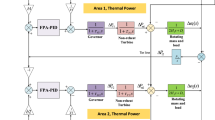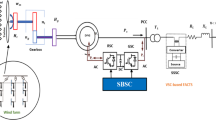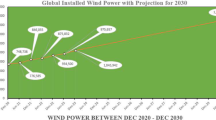Abstract
Among the renewable energy sources, wind turbines play a vital role in power generation. One of the effective ways of power regulating systems is the pitch-regulated wind turbine, which is used to interface the grid and generator smoothly. In this paper, a novel approach of a pitch-regulated wind turbine using an intelligent soft-starter-based induction generator is presented. A neuro-fuzzy approach has been used as an intelligent tool in the soft-starter to estimate the firing angle of thyristors accurately so as to integrate the generator to the grid smoothly. Various wind turbine models such as 600, 1,000, and 1,500 kW are taken for simulation and simulation results have been presented to prove the proposed methodology.
Similar content being viewed by others
References
Spera DA (1994) Wind turbine technology. ASME PRESS, New York
Rodriguez JLA, Rodriguez GF, Burgos JC (1998) Experimental rig to emulate wind turbines. International conference on electric machines, Istanbul, Turkey
Wilkie J, Leithead WE, Anderson C (1990) Modeling of Wind turbines by simple models. Wind Eng 13(4)
Bossanyi EA, Gardner P, Craig L, Saad-Saoud Z, Jenkins N, Miller J (1997) Design tool for prediction of flicker. European wind energy conference, Dublin Castle, Ireland
Akhmatov V, Knudsen H, Nielsen AH (2002) Advanced simulation of windmills in the electrical power supply. Int J Electr Power Energy Syst 22(6): 421–434
Leithead WE, Rogers MCM (1996) Drive-train characteristics of constant speed HAWT’s: part I—representation by simple dynamics models. Wind Eng 20(3)
Leithead WE, Rogers MCM (1996) Drive-train characteristics of constant speed HAWT’s: part II—simple characterization of dynamics. Wind Eng 20(3)
Bao NSh, Chen QX, Jiang T (1996) Modelling and identification of a wind turbine system. Wind Eng 20(4)
Jenkins N, Saad-Saoud Z (1996) A simplified model for large wind turbines. European union wind energy conference, Goteborg, Sweden
Usaola J, Vilar C, Amaris P, Ledesma P, Rodriguez JL (1999) Characterization of WECS through power spectra for power quality studies. European wind energy conference (EWEC ‘99), Nice, France, March 1–5
Larsson A, Srensen P, Santjer F (1999) Grid Impact of variable-speed wind turbines. Proceedings of European wind energy conference (EWEC ‘99), Nice, France, March 1–5, pp 786–789
Rodriguez JM, Fernandez JL, Beato D, Iturbe R, Usaola J, Ledesma P, Wilhelmi JR (2002) Incidence on power system dynamics of high penetration of fixed speed and doubly fed wind energy systems: study of the Spanish Case. IEEE Trans Power Syst 17(4): 1089–1095
Hansen LH, Helle L, Blaabjerg F, Ritchie E, Munk-Nielsen S, Bindner H, Srensen P, Bak-Jensen B (2001) Conceptual survey of generators and power electronics for wind turbines. Ris National Laboratory, Roskilde
Slemon GR (1989) Modelling of induction machines for electric drives. IEEE Trans Ind Appl 25(6)
Mihet-Popa L, Blaabjerg F, Boldea I (2004) Wind turbine Generator modeling and Simulation where rotational speed is the controlled variable. IEEE Trans Ind Appl 40(1): 3–10
Lei Y, Mullane A, Lightbody G, Yacamini R (2006) Modeling of the wind turbine with a doubly fed induction generator for grid integration studies. IEEE Trans Energy Convers 21(1): 257–264
Power System Simulator for Engineering. Power Technologies, INCr. http://www.pti-us.com
Kundur P (1994) Power system stability and control. McGraw-Hill, New York. ISBN: 0-07-035958-X
Jang JR (1993) ANFIS: adaptive-networks based fuzzy inference system. IEEE Trans Syst Man Cybern 23: 191–197
Purwanto E, Arifin S, So B-S (2001) Application of adaptive neuro fuzzy inference system on the development of the observer for speed sensor less induction motor. IEEE Tencon 1: 409–414
Akaayol A (1993) Application of adaptive neuro-fuzzy controller for SRM. Adv Eng Softw 35(3–4): 129–137
Blaabjerg F., Chen Z, Kjaer F (2004) Power electronics as efficient interface in dispersed power generation systems. IEEE Trans Power Electron 19(5): 1184–1194
Thiringer T (2002) Grid-friendly connecting of constant-speed wind turbines using external resistors. IEEE Trans Energy Convers 17(4): 537–542
Harnefors L, Nee HP (2000) Control of variable-speed drives. Royal Institute of Technology, Stockholm
MATLAB—the language of technical computing, The MathWorks, Inc.
Hammons TJ, Lai SC (1994) Voltage dips due to direct connection of induction generators in low head hydro electric schemes. IEEE Trans Energy Convers 9(3): 460–465
Author information
Authors and Affiliations
Corresponding author
Rights and permissions
About this article
Cite this article
Nallavan, G., Dhanasekaran, R. & Rajaji, L. Intelligent soft-starter-based grid-integrated induction generator for pitch-regulated wind turbine system. Electr Eng 92, 57–68 (2010). https://doi.org/10.1007/s00202-010-0162-6
Received:
Accepted:
Published:
Issue Date:
DOI: https://doi.org/10.1007/s00202-010-0162-6




